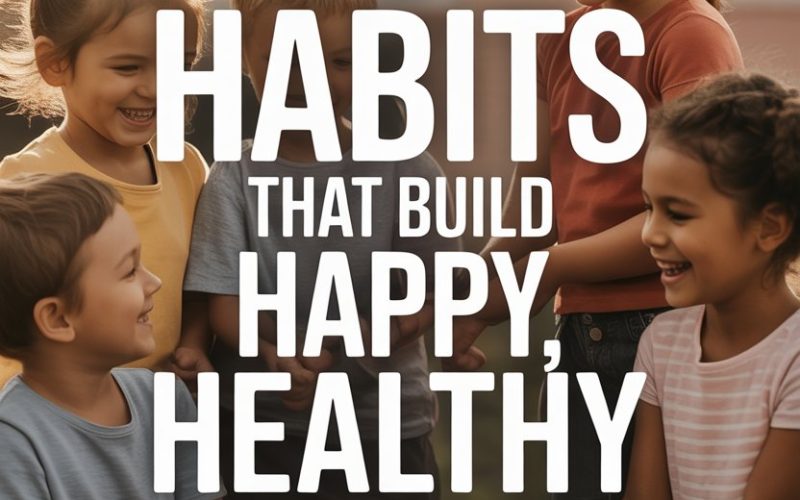Ever met a parent who isn’t busy? Me neither.
Between the school runs, last-minute costume days, and the endless requests for snacks (how do small humans eat so much?), forming habits that actually stick can feel like chasing a unicorn through a fog bank.
Still, even with calendars that look like a game of Tetris, families can weave in small things that lead to big results.
Here’s the good news: building happy, healthy kids isn’t about Herculean effort, Pinterest-level crafts, or producing bento boxes shaped like woodland animals.
It’s about creating little moments and routines that, over time, add up to something rather wonderful.
Let’s take a look at five habits that help kids thrive—no glitter glue required.
1. Consistent Sleep Routines
Before you roll your eyes and mutter, “Easier said than done,” hear me out. Sleep is the unsung hero of childhood (and, let’s be honest, adulthood too).
Kids need more sleep than most parents realize, and the benefits are almost magical: better moods, sharper concentration, a sturdier immune system, and even a buffer against tantrums that erupt over the wrong-colored cup.
The trick isn’t a military-grade schedule. It’s about setting a regular bedtime and wake time and sticking to it as closely as you can, even on weekends.
If you need backup, a study from the University College London found that children with irregular bedtimes had more behavioral difficulties than those with set routines.
Wind-down routines work wonders. Reading a story, sharing a few minutes of quiet chat, or a warm bath can signal that it’s time to switch gears.
For tech-loving families, experts say it’s best to keep screens out of the bedroom and wrap up digital play at least 30-60 minutes before lights out. Blue light, meet blackout blinds.
Now, if your child’s idea of bedtime is reminiscent of a game of whack-a-mole, you’re not alone. Keep the routine predictable, gentle, and as flexible as necessary.
Some nights call for negotiation. Others, well, you just need to choose your battles. Sleep hygiene doesn’t mean perfection—it’s about setting a rhythm your kids can count on.
2. Eating Together Whenever You Can
Sit-down family dinners have earned a bit of a reputation as the unicorn of modern parenting.
But before you toss the idea aside as old-fashioned, it’s worth noting that researchers keep finding positive links between eating together and better outcomes for kids—including higher self-esteem, healthier eating habits, and lower rates of risky behavior as teens.
No one says you need a candlelit banquet every night. A rushed breakfast counts. Thursday-night takeaway on the living room floor counts.
Even just a snack and a natter after school can do the trick. The magic isn’t in the food—it’s in the feeling of togetherness, the silly stories, the chance for everyone to take a breath and reconnect.
A University of Montreal study pointed out that regular family meals help kids develop better communication skills and emotional resilience. Make it a phone-free zone and encourage everyone to share one thing about their day.
And don’t stress about table manners—at least, not yet. (Unless your five-year-old thinks peas are best applied as hair product. Then maybe a brief chat wouldn’t hurt.)
Who cares if you’re serving fish fingers for the fourth night running? Your children will remember how it felt to belong.
3. Moving Their Bodies, Every Day
Exercise is often right up there with “cleaning under the beds” on kids’ lists of favorite things.
But daily physical activity is crucial not just for healthy bodies, but also for better sleep, moods, and even academic performance—a win-win for parents and children alike.
The World Health Organization recommends that children aged 5-17 get at least 60 minutes of moderate to vigorous physical activity per day.
That might sound like a lot, but it all adds up—walking to school, scooter races, backyard trampolines, kitchen dance parties, or even helping carry in the groceries.
You don’t need to sign up for every after-school club or haul everyone to the local pool at 7am on a Saturday (unless, of course, you enjoy torture).
Model movement as normal. Walk to the bakery, take the scenic route home, race the kids to the letterbox. Bring the fun, not the pressure.
The aim isn’t to raise the next Olympic champion—just to help your kids fall in love with moving their bodies.
And if it rains? Wellies and puddles never go out of style.
4. Making Space for Big Feelings
Ever seen a toddler lose their mind because their banana snapped in half? Children’s emotional lives can be… intense. But supporting kids’ mental and emotional wellbeing is just as important as checking off their immunization records.
Kids need to know that all their feelings—big, small, or somewhere in between—are allowed. The trick is helping them find ways to express, name, and manage those feelings, without shame or punishment.
According to child psychologist Dr. Laura Markham, validating your child’s emotions (even when you don’t fully understand them) builds trust and emotional intelligence.
Here’s what that looks like: “You’re really sad because your tower fell over. That’s hard.” Simple words, offered with a cuddle or a gentle hand, show your child that their inner world matters.
Model healthy ways to handle frustration, disappointment, or anxiety. Show them it’s okay to ask for help. (And if you accidentally snap when someone spills juice on your tax return, apologize.
Children don’t need perfect parents—they need honest ones.)
For older kids, create moments to talk about emotions, not just during meltdowns. Chat in the car, during walks, or while folding laundry together.
You don’t have to solve every problem. Most of the time, just listening is enough.
5. Prioritising Play and Downtime
If there’s a single word that sums up childhood, it’s “play.” Yet, these days, unstructured playtime is often squeezed between violin lessons, spelling lists, and the Herculean feat of finding matching socks.
Play is crucial for everything from social skills to creativity to stress relief…and it’s not just for the little ones. Teens, too, benefit from silliness and time out from screens and schedules.
According to the American Academy of Pediatrics, play is so important for healthy development that it’s considered a basic human right.
Unsupervised, unstructured play helps kids learn how to solve problems, negotiate with others, and make sense of the world. That’s a lot more impact than any flashcard app can boast.
Create space for free play—even if it means a messier lounge or a longer list of chores. Build a fort out of sofa cushions, encourage backyard adventures, or simply let your children be bored and see what happens.
Boredom is a breeding ground for imagination. (Also, it’s character-building for parents.)
Downtime matters, too. Overscheduled children become stressed children.
Give your kids permission to pootle, doodle, or simply lie on the grass and watch clouds. It’s good for them—and for you.
Raising Resilient, Joyful Kids Isn’t About Perfection
If you’re reading this while reheating coffee for the third time today, know this: small, imperfect habits are the backbone of happy, healthy kids.
There’s no magic formula, no need for superhuman effort—just daily, doable moments of connection, movement, sleep, nourishment, and play.
Miss a family meal? Rough night with the bedtime circus? Stuck indoors thanks to a rogue stomach bug? Welcome to parenthood.
What matters isn’t getting it right every time, but returning to these habits, again and again, as best you can.
You’re already doing so much better than you think.
And those kids of yours? They’re lucky to have you—banana meltdowns and all.





